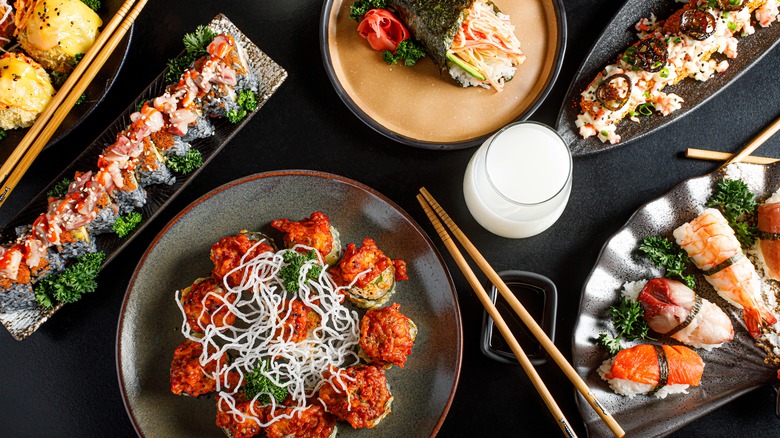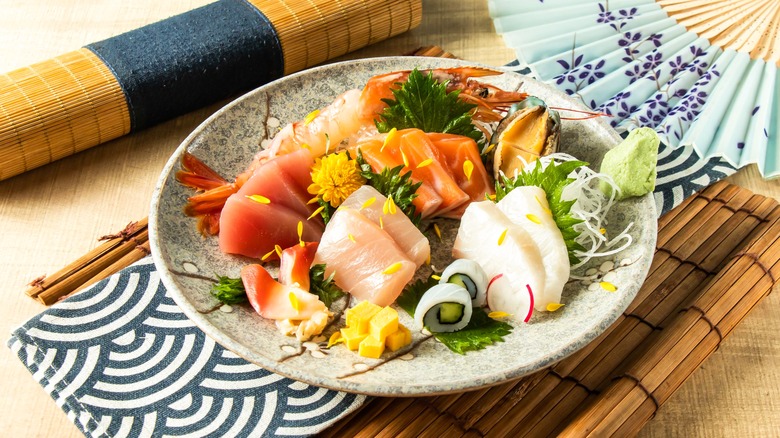Sushi Vs Sashimi: The Major Difference Explained
People often confuse sushi and sashimi. However, the difference lies in the rice. More specifically, sushi is any food that involves sushi rice, which is a rice seasoned with vinegar. Sashimi, on the other hand, refers to raw meat — usually fish, but not always — that's cut a certain way. The word "sushi" is a combination of the words "su" and "meshi," which means "vinegar" and "rice," respectively. Often, this vinegared rice is paired with raw fish, but it's also not unusual to find foods like Japanese omelet, cooked meat, or an assortment of vegetables on a sushi platter.
Sashimi translates as "pierced meat," which very often is fish, but it can also be other types of proteins, including red meat or game meat. Possibly the most notable difference is that, unlike sushi, sashimi is served sans rice. It's also typically served raw, though some of the meats are subject to some cooking, often to sidestep the possibility of food poisoning or to take the texture to the next level. The sashimi chef's various knife skills ensure that the sliced food looks pretty and smooth on the plate, regardless of whether the meat is cooked or not.
While you'll learn best about the differences between sushi and sashimi by eating them, there are elements about each that are useful to be aware of. This knowledge helps you to better enjoy the culinary experience when you're eating this Asian cuisine.
Types of sushi
Nigiri and maki rolls count as some of the types of sushi you'll find. Nigiri is that little oblong-shaped ball of rice that looks like it's sporting a pompadour hairdo made of fish. Not all pieces of sushi have that hairdo, however. For example, maki rolls wear an overcoat of nori seaweed, omelet, or thinly sliced cucumber. Inside the overcoat are the usual suspects: Rice, of course, as well as proteins like raw tuna, cooked crab, chopped carrots, or sweet potatoes, to name but a few. It's the stuff that Costco sushi platters are made of, though in all fairness, you'll often see nigiri on those, too.
Other types of sushi exist, too. For example, eating temaki sushi is, in appearance, a bit like eating a seaweed ice cream cone. Fish and vinegared rice get stuffed inside a cone-shaped piece of nori seaweed and eaten with your fingers. And if you're a fan of tofu, then you might like inarizushi, which is tofu stuffed to the gills with rice.
Finally, it's also important to remember that sushi can vary, depending on whether you're eating it in the West or in Japan (or elsewhere), due to regional differences. So, if you want to eat sushi like a pro, then keep your mind open and your chopsticks poised for adventure. This ensures that you'll enjoy your sushi experience no matter where you're eating it in the world.
The lowdown on sashimi
For the sashimi chef, superior knife skills are of the utmost importance. The chef must have the ability to cut the meat so that there are jagged edges and odd shapes. This isn't to say that all the meats on the plate are cut the same way. They aren't. You'll see cubes, rectangles, and diagonals, as well as thin strips of fish on a restaurant sashimi platter. Each type of meat is cut in a specific way because the cut improves the texture and mouthfeel. Here's one example. Thickly cut octopus feels rubbery in the mouth. To prevent this, octopus is sliced thin so that it tastes yummy AND feels good to the mouth.
Maguro, aka tuna; yellowtail or hamachi; saba, or mackerel; and finally, salmon, otherwise known as "sake" (and salmon roe), count among the most common types of sashimi fish. Some of these fish are cured to kill the fish's natural bacteria. It might also be cured to mitigate the fishy smell. Take mackerel, for example. It is usually cured before being served as sashimi due to it being prone to spoiling quickly.
Finally, if you've never eaten sushi or sashimi before, consider starting off with sushi. Because sushi includes rice, starting off with that may be less intimidating than diving straight into a platter of raw meats and little else. Once sushi teaches you that raw fish really is delish, move on to sashimi.


